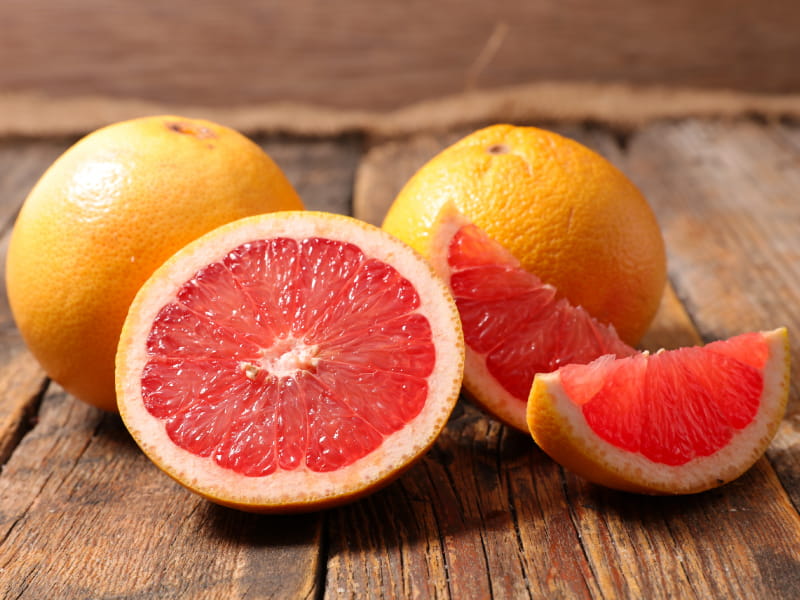Before grabbing a grapefruit, understand its power
By American Heart Association News

Grapefruit looks sweet and friendly, but you might have heard it possesses powers far beyond those of ordinary produce.
Some of that reputation is fact, and some is myth.
Facts first: According to the U.S. Department of Agriculture, half a medium grapefruit has only 41 calories and nearly half a day's recommended supply of vitamin C.
"In addition, it's a reasonable source of potassium," which is important for maintaining healthy blood pressure, said Karen Collins, a registered dietitian in western New York who specializes in cancer prevention and heart health.
Grapefruit also is laden with natural plant compounds called phytochemicals, specifically flavonoids, which studies show can help fight stroke and heart disease. Pink and red grapefruit are good sources of beta carotene (a source of vitamin A) and lycopene, an antioxidant "cousin" to beta carotene that has been linked to lower stroke risk. One cup of red or pink grapefruit sections has as much lycopene as a medium 4-ounce tomato.
That's all good. But grapefruit's reputation for interfering with some medications is well-deserved.
It particularly affects certain anti-cholesterol statin drugs, as well as some medicines used to treat high blood pressure, irregular heartbeats and even allergies. Grapefruit and grapefruit juice can cause too much or too little of a drug to stay in the body. Too much drug increases the risk of side effects; too little means the drug may not work as well.
If you enjoy grapefruit or grapefruit juice and take such medications, there's no need to panic, Collins said. But talk with your pharmacist or health care provider to clarify what's safe. They might be able to switch your prescription to something unaffected by grapefruit, or even advise you to simply watch the timing of when you eat it.
In the past, grapefruit has been the very symbol of a "diet" food. Here's where its reputation drifts into the realm of fable.
"The things that are not true are that grapefruit has some kind of magical power, or contains some kind of fat-burning enzyme, that you're going to eat it and burn calories while you're sleeping," Collins said. Studies have found grapefruit provides no special boost to weight loss.
Even so, grapefruit's tartness encourages people not to gulp it in a rush but to slow down, letting them feel full with relatively few calories, "and that is exactly an approach that research does support as the kind of eating pattern that helps people reach and maintain a healthy weight," Collins said.
The classic way to enjoy grapefruit – splitting it and eating with a spoon – is OK, she said. (Be sure to rinse it before you cut: Otherwise, the knife might push bacteria on the skin through the entire fruit.)
But if you peel it like an orange and eat it by the section, you get added benefits from the membranes.
"Those membranes are rich in a type of dietary fiber called pectin, which is what we would call a viscous fiber," Collins said. "And that is the type of fiber that can help lower (bad) LDL cholesterol and seems to be what they call a prebiotic that helps to nurture the healthy bacteria in our gut."
For the best flavor, don't chill it.
"It's actually recommended that if you're going to be eating grapefruit within the week to just store it at room temperature," she said. It can keep for several weeks in the refrigerator, but it will taste better if you let it return to room temperature before serving.
She recommends trying it in a salsa, with chopped bell peppers and cilantro. "That adds a really nice, very crisp and refreshing kind of flavor like, say, on fish." She also thinks the sections work great on a green salad. "You can combine it with avocado, and that's kind of a classic."
And if you're in the habit of taking it with a sprinkling of salt or sugar?
First, she suggests, try it plain. "The grapefruit of today is really not necessarily the grapefruit of 30 years ago, and many of them don't have as bitter a taste."
Although most Americans already consume too much sodium and sugar, a tiny sprinkle of salt on half a grapefruit or a bit of brown sugar on a slice you stick under the broiler is "a drop in the bucket" compared with other choices you could make, Collins said.
"If you're saying a quarter of a teaspoon of sugar makes it so you enjoy that grapefruit compared to a doughnut that has eight teaspoons of sugar in it, I would take the grapefruit."
If you have questions or comments about this story, please email [email protected].
Eat It or Leave It?
Not sure if what you’re putting on your plate is healthy? The Eat It or Leave It? series from American Heart Association News covers the science behind foods and drinks, with an expert look at the health pros and cons.






